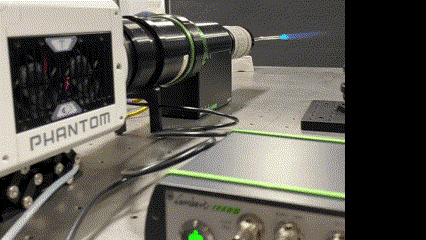The High-speed intensified Camera Attachment (HiCATT) from Lambert Instruments is a highly customizable instrument that can be fitted with a variety of photocathodes to give the highest sensitivity from UV to NIR wavelengths. The entrance of an image intensifier occurs through the photocathode (1), where incoming photons are converted to electrons to start an amplification process at the Micro-Channel Plate, or MCP (2). The photocathode is the element that defines the overall spectral response of the intensifier, or the sensitivity to the wavelengths generated by the process being imaged.


Second Generation, or Gen II, intensifiers have a multi-alkali photocathode. Gen II photocathodes such as S20, S20B, and Hi-QE Blue (figure on the left) are the to-go option in imaging applications involving spontaneous emission and Planar Laser Induced Fluorescence (PLIF) in plasmas and combustion processes due to their high quantum efficiency in the UV region down to 200 nm.
In third Generation, or Gen III, intensifiers the multi-alkali photocathode is replaced by a semiconductor Gallium Arsenide (GaAs) or a Gallium Arsenide Phosphide (GaAsP) photocathode. These photocathodes have a much higher quantum efficiency, exceeding 50% at some wavelengths, which enables higher signal-to-noise levels and allowing the use of shorter gates. Gen III intensifiers have the highest performance, but their sensitivity is mostly limited to visible and near-infrared wavelengths.
Although the QE of a photocathode such as GaAsP steadily decreases below 400 nm, it does not dip below 10% until wavelengths under 300 nm, making it a viable alternative to image chemiluminescence in combustion processes. Chemiluminescence in hydrocarbon flames is characterized by radiation originating from processes involving excited radicals such as OH*, CH*, and C2*. This chemiluminescence spans the UV/Visible range and is used in optical diagnostics of flames to get insights into the structure, dynamics, and chemistry of combustion. The emission of OH* occurs between 280 and 330 nm, with the most prominent (0,0) band occurring around 308 nm. The strongest CH* and C2* emission bands occur in the visible range near 432 nm and 517 nm.
OH* Chemiluminescence Imaging in a Flame Using a GaAsP Intensifier
The figure below shows a typical QE curve of a GaAsP photocathode in a HiCATT intensifier and an emission spectrum of the most prominent chemiluminescence signals in a hydrocarbon flame for reference. Although a Gen III intensifier cannot be used to image wavelengths below 300 nm (for example in experiments involving spontaneous emission or Laser Induced Fluorescence of species like NO, CO), it is well suited for imaging the chemiluminescence of major combustion radicals such as OH*, CH* and C2*, as well as LIF of species such as OH and CH emitting in the UV region above 300 nm and the visible region.

The following high-speed imaging example was performed to illustrate the use of a GaAsP intensifier to image the UV chemiluminescence of OH* in a flame using a butane torch that generates an atmospheric pressure diffusion flame. The complete imaging system consists of the following components:
• A Phantom T3610 high-speed camera with a maximum speed of 38,000 fps at its full 1 Mpx resolution of 1280 x 800
• A 25mm HiCATT hybrid image intensifier with a Gen III GaAsP photocathode and a peak quantum efficiency of 50%
• A 100 mm f/2.8 CERCO UV lens with 90% transmission between 250 nm and 410 nm



The HiCATT is a highly customizable instrument to perfectly match to your application:
• A wide variety of Gen II and Gen III photocathodes to provide the highest sensitivity at the wavelength range of your choice, from UV to NIR.
• Choice of P46 or P47 phosphors with different decay times for the perfect balance of intensifier overall efficiency vs. frame speed.
• User-exchangeable relay optics to achieve the optimal match between the intensifier and your camera sensor and pixel pitch, every time.
• Choice of gate electronics to cover every need from ultra-short exposures down to 3 ns, to ultrahigh-speed imaging in the MHz regime.
• A variety of control units to accommodate any experimental needs, from simple analog gain adjustment to more complex applications requiring multiple channel pulse/delay generators and programmable gate patterns.

For more information about the HiCATT camera attachment, visit our:
or email us: @[email protected]
